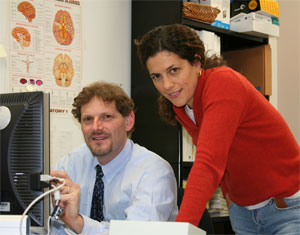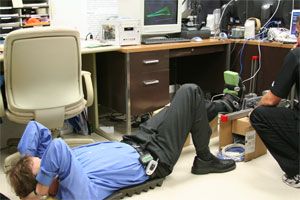House Call: Home Health Care Goes Wireless
By Jonathan Cheung
03.22.06 --If Dr. Steven C. Cramer has his way, spinal cord injury (SCI) patients in remote locations could have their therapeutic progress tracked by a doctor or physical therapist without leaving the comfort of their own homes. Funded by the Calit2 Nicholas Foundation Award for Cross-Disciplinary Research, the UCI associate professor of neurology has teamed up with Crista Lopes, assistant professor of information and computer science, and with Project Walk, a Southern California-based SCI recovery program. Together, they are designing a self-contained communications platform that makes in-home health care administration and monitoring readily available for SCI patients.
|
“These are people who cannot come to the office and get examined very easily, so we are using wireless communication technology to enable repeated measurements from afar,” says Cramer. “The project really fits into the mission of Calit2.”
There are two main goals for the project: to measure the gains of SCI patients who undergo intense physical therapy and to test the wireless component of the communications platform designed to monitor patients’ neurologic status. To accomplish this, Cramer is conducting a pilot study involving a test group of Project Walk participants who will undertake a rigorous six-month exercise program and a control group of volunteer SCI patients not enrolled in any recovery program. At the beginning of the study, both groups will undergo a short battery of tests at UCI, including brain mapping, and will subsequently be tested at regular intervals.
One communications platform, which consists of a laptop connected to a broadband modem, webcam and several testing devices – including a harness, a goniometer for measuring joint angles and a custom-designed apparatus – will be installed at the Project Walk center in Carlsbad, Calif. There, personal trainers will use the laptop to log each patient’s exercise hours, as well as recordings taken from devices that measure balance, muscle strength and range of motion. This information will be sent by the broadband modem back to UCI to be studied by Cramer and his post-doctoral fellow, Nuray Yozbatiran.
|
The control group will also have a communications platform with a modem and webcam, but only a harness and goniometer as testing devices. This group will be tested only for balance and range of motion at the knee; this information will also be sent back to Cramer, who expects little or no improvement from these patients. Because there is only one available platform, it will be installed for one week at a time in different control patients’ homes.
Since Internet access was not a requirement for patient participation, Lopes, who is in charge of the remote data transfers, considered many options and ultimately decided upon a Verizon broadband modem. The modem uses Verizon’s cellular network bandwidth and once connected, allows the laptop to transfer data to the server computer using file transfer protocol. Since coverage provided by the modem depends on Verizon’s coverage, Lopes will determine how well the connection works in remote locations.
Another challenge was deciding how to digitally quantify the gains made by SCI patients. “Usually when a doctor examines an SCI patient, it involves a 20-minute analog exam with comments such as ‘weaker today’ or if there’s a scale, they measure the number: ‘hip is three, ankle is two, knee is zero,’” explains Cramer. Cramer’s team solved the problem by constructing custom devices that quantitatively digitize measurements, recording range of motion as the number of degrees at joints and strength as Newtons of force.
The benefit of intense exercise for SCI patients has received limited scrutiny to date, though results appear promising. Eric Harness, director of research, training and development at Project Walk, believes that quantifying the improvements will lead to further acceptance and more options for SCI patients. “I believe if this project is successful, it may be the beginning of a paradigm shift in the medical community, where insurance will be willing to pay for a portion of the program, and doctors will be more willing to bring up the subject of functional recovery to newly-injured patients,” declares Harness.
Project Walk also offers an in-house program and is opening a second center in Portland , Ore. With patients in different places, a platform capable of real time data transmission will allow increased collaboration between the facilities. And studying whether this technology can improve patient therapy is just the beginning. “I would like to instrument the patients’ houses with more sensors,” says Lopes. “We want to be able to monitor different aspects of their daily activities and be notified in case of emergency.” Cramer adds, “Measuring neurological status remotely could open up a range of new options for reaching more patients with time-sensitive therapies and for monitoring home therapies in a range of conditions.”
--Jonathan Cheung



